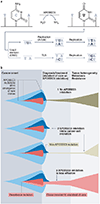Addressing the benefits of inhibiting APOBEC3-dependent mutagenesis in cancer
- PMID: 36280735
- PMCID: PMC9700387
- DOI: 10.1038/s41588-022-01196-8
Addressing the benefits of inhibiting APOBEC3-dependent mutagenesis in cancer
Abstract
Mutational signatures associated with apolipoprotein B mRNA-editing enzyme catalytic polypeptide-like (APOBEC)3 cytosine deaminase activity have been found in over half of cancer types, including some therapy-resistant and metastatic tumors. Driver mutations can occur in APOBEC3-favored sequence contexts, suggesting that mutagenesis by APOBEC3 enzymes may drive cancer evolution. The APOBEC3-mediated signatures are often detected in subclonal branches of tumor phylogenies and are acquired in cancer cell lines over long periods of time, indicating that APOBEC3 mutagenesis can be ongoing in cancer. Collectively, these and other observations have led to the proposal that APOBEC3 mutagenesis represents a disease-modifying process that could be inhibited to limit tumor heterogeneity, metastasis and drug resistance. However, critical aspects of APOBEC3 biology in cancer and in healthy tissues have not been clearly defined, limiting well-grounded predictions regarding the benefits of inhibiting APOBEC3 mutagenesis in different settings in cancer. We discuss the relevant mechanistic gaps and strategies to address them to investigate whether inhibiting APOBEC3 mutagenesis may confer clinical benefits in cancer.
© 2022. Springer Nature America, Inc.
Figures



References
Publication types
MeSH terms
Substances
Grants and funding
LinkOut - more resources
Full Text Sources
Medical

